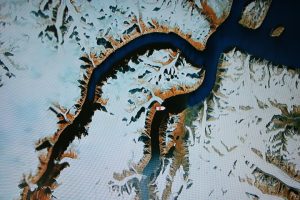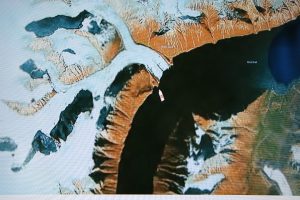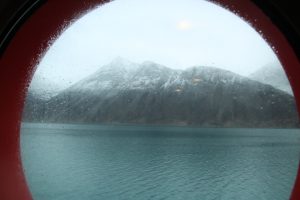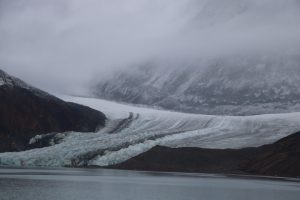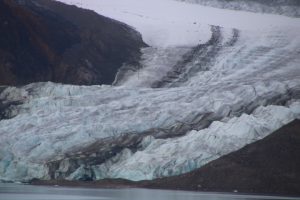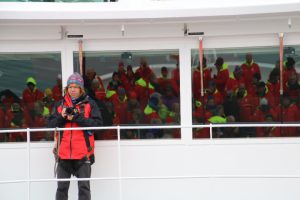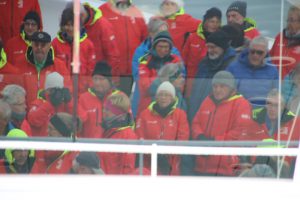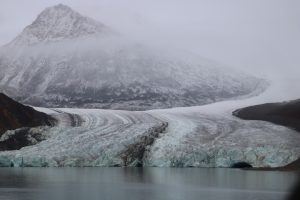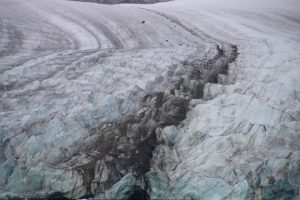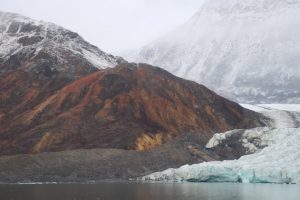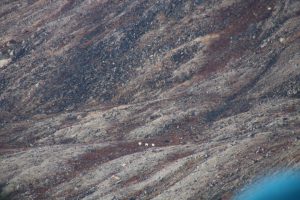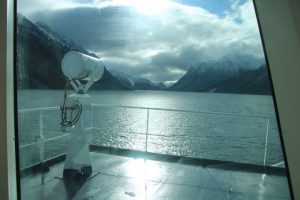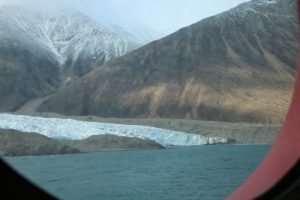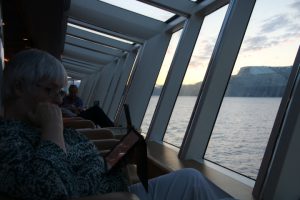After breakfast we were at 72° 08´ North, 74° 58´ West off the northeast coast of Baffin Island and Cape Jameson. We are approaching the South Arm Fjord and will sail in between snow-capped, granite mountains to the glaciers at its head. The island is named after the English explorer William Baffin but it is thought to have been regularly visited by the Norse peoples from Greenland and Iceland, though we have not seen any archaeological evidence.
Upon reaching the head of the fjord we had a team photo opportunity at the bow of the ship. Whilst we were here a polar bear family (mum and 2 cubs) was spotted but unfortunately the ships engines made them run away.
Group photograph on Deck 5.
This isn’t much but if you look carefully you will see a mother polar bear leading her two cubs away from the ship.
The trail of Franklin went cold until 2008 when the Canadian Prime Minister gave Parks Canada funding for a three year effort to find the wrecks of Erebus and Terror. Underwater searches began and side-scan sonar but it was not until 2014 when an iron davit was found on an island in the Queen Maud Gulf on 1st September. The next day Parks Canada found the wreck of Franklin’s flagship Erebus. Further work continued until 2016 when a tip-off from the Inuit guide Sammy Kogvik led to the discovery of the well-preserved wreck of the Terror. Such modern archaeology is beginning to ‘fill in the gaps’ between supposition, theory and the artefacts recovered from local people by explorers such as John Rae. His collection of cutlery, personal effects, everyday artefacts and most importantly the medal of the Hanoverian Order of Merit that Franklin was wearing in the photograph taken prior to his 1845 departure proved where Franklin had been. McClintock found a skeleton of a uniformed naval steward and the Victory Point note mentioned earlier. These early recoveries of artefacts led the Admiralty to believe that all of Franklin’s expedition had perished and convinced the British public by the 1880s to believe there was no need for anymore searching. Franklin’s expedition dropped out of the news only to resurface in 2014/16. A major exhibition of the ‘old’ and ‘new’ artefacts were displayed at the National Maritime Museum in November 2017 and in March 2018 in the National Museum, Ottawa, Canada.
This new archaeology is helping to explain a contentious theory related to lead poisoning of members of both ships. Beattie and Geiger (Frozen in Time) describe their exhumation of the three bodies on Beechey Island. This was in the 1980s. Their exhumations showed that the men were suffering from scurvey, but that was not unusual on long voyages. What was unusual was the lead found in bones and tissue. They suggested that the supplies of food that were preserved in tins had been contaminated by lead being washed out of the solder by the salt preserving the food. Nearby was a cairn made from 600-700 gravel filled tins which indicated that Franklin may have determined that the food was poisonous and so disposed of the food and used the cans to inform people who came later. The evidence from 2016 concludes that lead poisoning takes a lifetime of permeation by the lead but a quicker way of infiltrating the body is possibly provided by the ‘state of the art’ desalination plant on both ships. New lead pipes with hot water regularly used and consumed is perfect for getting high levels into the body quickly. There has been some more evidence from bones and skeletons recovered of butchery and the use of knives to remove flesh from bones as well as ‘pot-polish’ in cooking pans used for boiling meat and bones before eating. One final use of science in archaeology is skull and facial reconstruction. These reconstructions when compared to the photographs that many of the officers had taken before sailing, is enabling the names of officers to be accurately matched with skull and photograph. E.g. Lt. H. L. Vesconte is now thought to be the ship’s doctor Goodsir. These up-to-date elements were provided by an onboard lecture on the Fram.
We end the day with amazing sunshine and associated change in colours on the two billion year old mountains. As we write we are entering Baffin Bay and heading to Pond Inlet, our point of departure from The Passage.
